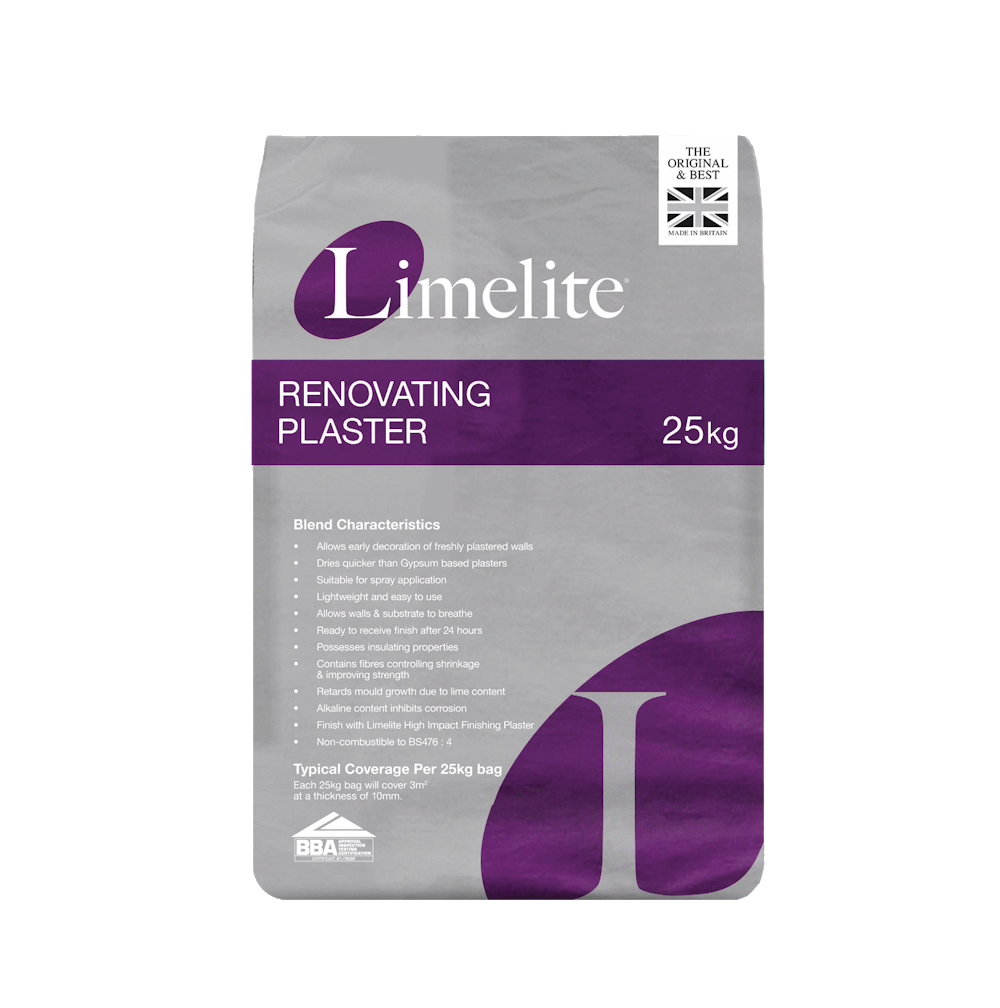Modern, breathable, quick drying lime plasters
The UK plaster market has been heavily shaped in the last 50 years by the popularity of gypsum plasters and plasterboard. Quick to install and cheap to buy, they have become the go-to solution for plasterers across the country. Although gypsum plaster products are cost effective and convenient, they have a number of drawbacks that can cause problems in some situations.
There has also been a perception that Lime plasters are difficult and time consuming to prepare and to use. However, developments in lime materials have created a range of modern pre-blended lime plasters that are quick and convenient to use straight from the bag. These modern lime renovating plasters are light weight, easy to apply and finish and avoid some of the issues associated with gypsum plasters.
Plastering is a skill that requires time, experience and practice to perfect. Preparing and using traditional lime plasters, renders and mortars is an art form and takes many years of experience. However modern Lime based building materials like Limelite provide and more accessible alternative, combining the convenience and usability of modern gypsum plasters and cement mortars with the some of the material characteristics of lime plasters and mortars. As a result, they give tradesmen and wider choice of materials and another ‘tool in their box’ when working with older buildings and new projects that use traditional construction methods.
While the skill of mixing and applying traditional lime plasters may be less common in the modern construction industry and there is a well-publicised skills gap among trade professionals, this is less of a problem for modern lime renovating plasters. Limelite plasters are lightweight, easy to mix straight from the bag by adding water and are applied using standard plastering tools and techniques without any additional training requirement.
• Older buildings built before 1930
• Solid walled brick or stone buildings used as residential accommodation, offices, hotels, restaurants or as entertainment venues
• Extensions of renovation of older homes with existing lime plaster
• Basement conversions as part of basement lining systems
• Moisture sensitive storage in buildings like museums, galleries or car storage facilities.
• Homes or commercial buildings on flood plains of at risk of flooding
Older, solid walled houses and buildings can be prone to damp and mould as moisture created by the occupants, particularly from kitchens and bathrooms condense on cold, poorly insulated walls. Gypsum plasters can make this problem worse as they are hygroscopic and absorb and retains moisture from the surrounding atmosphere and substrate. This means they stay damp and can lead to mould and mildew.
Limelite renovating plasters deliver thermal conductivity value on average three times lower than gypsum plasters. This increased thermal efficiency is due to the use of expanded perlite, which improves the insulation properties of the wall – making it warmer to the touch – as well as reducing the density.
Modern lime plasters like Limelite are breathable, allowing any moisture that condenses on the wall or held within the fabric of the building to be released. Less retained moisture helps to prevent mould growth. It also protects adjoining architectural features like timber beams, stone or metal fittings from mould and corrosion.
Limelite Heritage Lime Mortar is available in six standard colours to complement a wide range of traditional brick and stone. A colour matching service is available allowing us to match samples from our client’s site.
Limelite Heritage Lime Mortars allow for slight movement and thermal expansion throughout the life of the building. This puts less strain on surrounding brick and stone and reduces the risk of damage to the building. Limelite also offer a range of Hydraulic Limes & Lime Putty.
Limelite Mortars are also breathable, allowing moisture to naturally evaporate and reducing the risk of trapped moisture and mould growth.
Limelite plasters are proven to help ambient moisture control in sensitive environments like galleries and museums. They have been chosen for use in moisture sensitive locations such as storage facilities in museums, art galleries and for storage of car collections. However this is also useful for moisture generating applications like gyms, indoor swimming pools or spa facilities. As Limelite are breathable and moisture resistant, they are a popular choice for use with cavity drain membrane systems and tanking systems in converted basements.
Homes, shops, restaurants or commercial buildings in flood risk locations need special consideration when it comes to the choice of plaster. When buildings are flooded it is important that they dry out quickly to allow the occupants to re-enter the building and prevent the growth of moulds.
Limelite Renovating Plaster is breathable so it can be applied directly to damp walls and allows continued release of any moisture absorbed by the walls. It also dries quickly with additional coats applied in as little as 24 hours. This means faster completion and less disruption for residents and business owners.
As Limelite plasters allow moisture to escape, they also help buildings to dry more quickly in the unfortunate event of future flooding, meaning improved future resilience for flood risk properties.
Conversion or barns or other historic buildings needs a high level of expertise and careful choice of building materials. Often existing timber, stone or brick work can be fragile. Preserving these materials along with the character of the original building is vital. Careless use of modern plasters or cement-based mortars or renders can damage existing structures by either trapping in moisture or in the case of cement mortars or renders producing a strong, rigid bond that transfers any stresses from movement in the structure into the weaker brick or stone. Limelite plasters and mortars are designed to complement the look of old buildings but also reflect the breathability and natural movement of traditional lime mortars and plasters.


